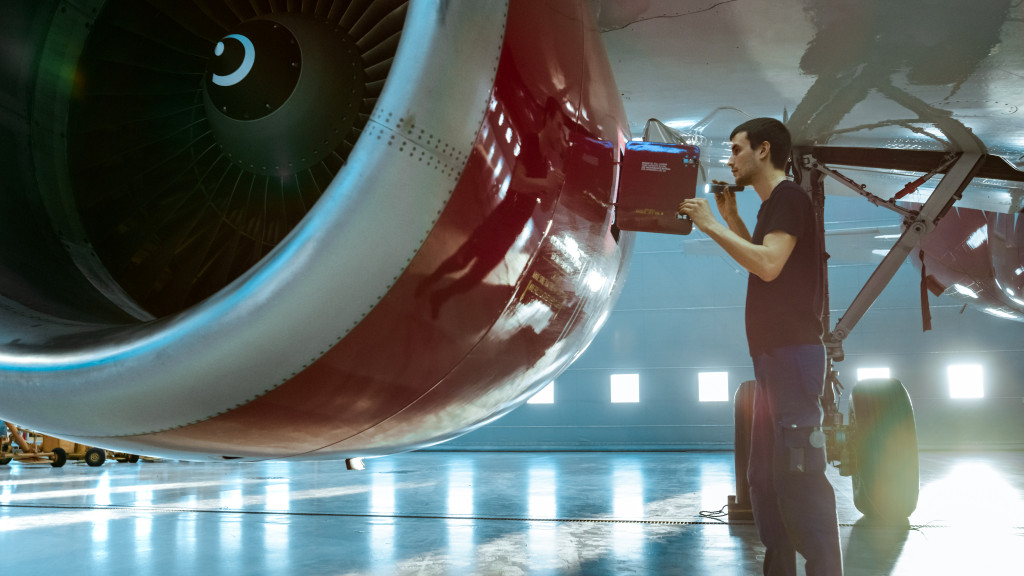Maintaining an aircraft is crucial to keeping passengers and crew safe in the air. Regular, rigorous maintenance checks are necessary for various reasons, from ensuring normal performance to meeting safety regulations. Here are some of the most important maintenance practices that should be done on an aircraft regularly.
1. Engine Maintenance
The engine is the heart of any aircraft. It powers the plane through its flight and must be adequately maintained to ensure it works correctly during the entire journey. This includes checking the engine oil levels, fuel filters, and spark plugs on a regular basis, as well as inspecting all parts for signs of wear or damage.
To do this, regular engine runs should be performed and monitored to check for any irregularities in performance. Additionally, the engine should be inspected for corrosion or other signs of damage that could cause a malfunction during flight.
For instance, the fan blades should be inspected to ensure they are free of any debris or damage. If there is an issue, the fan blades must be replaced immediately to avoid any risk of them failing during flight.
2. Airframe Maintenance
The airframe is the structure that holds all other components together and keeps them in place while in flight. It needs to be checked regularly to ensure it is in good condition and that there are no cracks or fatigue in any parts that could cause a problem during flight.
This includes checking control surfaces such as wings, tailplanes, elevators, rudders, flaps, and slats for any damage or deterioration due to wear and tear over time. You can check these by inspecting the aircraft’s skin for any dents or cracks which would indicate a problem.
You should also inspect all joints and other components of the airframe to ensure that there are no loose parts that could come off during the flight. Additionally, check for corrosion and make sure these areas are treated with an anti-corrosion agent.
3. Propeller Maintenance
The propeller is responsible for providing thrust to propel the aircraft forward at high speed during takeoff and landing maneuvers. It must be inspected regularly to check for any signs of damage or wear and tear that could lead to failure during flight operations.
This involves checking its blades for any signs of corrosion or cracking and examining its hub for signs of stress or fatigue due to operating over long periods of time with high loads being applied.
In addition, the bolts and nuts should be checked for any signs of loosening that could cause the propeller to become detached in flight. The pitch angle of the blades must also be checked to make sure it is set correctly for takeoff and landing performance.
Finally, pay special attention to the lubrication of the propeller, as this keeps it running smoothly and prevents any excessive wear on the blades.

4. Aircraft Lights Maintenance
The aircraft lights are one of any plane’s most important safety features. These lights must be regularly inspected to ensure that they all work correctly and that there is no damage or deterioration in the wiring.
This includes checking the aircraft light bulbs for any signs of damage or corrosion and ensuring that they are still bright enough to be visible during night flight operations. The fuselage lights should also be checked to ensure they are securely mounted and not prone to falling loose in flight.
Additionally, the landing lights should be inspected to ensure that their intensity is set correctly for safe landings at different airports.
5. Avionics & Electrical System Maintenance
Avionics systems are essential components of modern-day aircraft; they include navigation systems, radar systems, communication systems, and autopilot systems which help pilots accurately navigate their way through complicated airspace without incident or error while also providing information about weather conditions and terrain features along their route.
All these systems need to be inspected regularly so they continue functioning accurately throughout each flight without fail, which can save lives in emergency situations when precision is needed most!
Also, the aircraft’s electrical system needs to be maintained regularly. This includes checking all wires and connections for signs of corrosion or wear and tear that could cause sparks or shorts during flight.
6. Cabin Systems Maintenance
Ensuring those cabin systems, such as climate control systems (heaters/air conditioners), oxygen masks/regulators, fire extinguishers/smoke detectors, etc., are working correctly will not only provide passengers with comfort but also improve safety onboard an aircraft if an emergency situation were ever to arise unexpectedly mid-flight.
These should always be checked before every flight departure so that nothing is overlooked or forgotten about when it comes time to take off. Schedule regular maintenance checks of these systems to make sure they are all running correctly and no parts need to be replaced or serviced.
Properly maintaining an aircraft is essential for ensuring passenger safety and comfort alike — from engine maintenance to cabin system maintenance, there are many different steps involved, but if all are followed, then you can guarantee your passengers will have a smooth journey from takeoff to touchdown. By following these critical maintenance practices, you can ensure that your aircraft remains reliable at all times so your passengers can enjoy peace of mind when flying with you!
